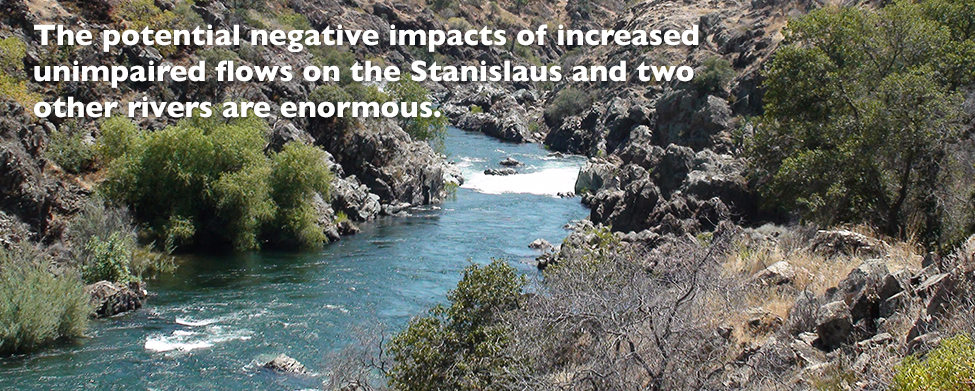
The state water board defines unimpaired flow as “the river flow that would occur if all runoff from the watershed remained in the river, without storage or diversion.” There haven’t been truly unimpaired flows since the first reservoirs were constructed more than 100 years ago.
Today, under a federal flow criteria called the OCAP Biological Opinion, unimpaired flows on the Stanislaus River are about 30% from January to June. The state plan announced Sept. 15, 2016, seeks at least 40-50%. With the current water rights of the districts, there would be no water for storage or other basin uses and less water for agriculture and human consumption in order to make up for the over commitment to unimpaired flows.
The San Joaquin River and its tributaries (including the Stanislaus River) are the state’s Phase 1 target of its Water Quality Control Plan for the Delta. Its Phase 2 target is the Sacramento River. While the state has not directly acknowledged that increasing unimpaired flows is related to Gov. Jerry Brown’s twin tunnels project, for those who are impacted, it’s hard to think they aren’t linked. The more water diverted from the Stanislaus, Tuolumne and Merced rivers into the Delta allows more water from the Sacramento River to feed the tunnels and be sent south.
The potential negative impacts of increased unimpaired flows on the Stanislaus, Tuolumne and Merced rivers are enormous.
Agriculture in San Joaquin, Stanislaus and Merced counties is worth more than $8.5 billion annually, with those dollars circulating many times over. The state’s plan could divert more than 350,000 acre-feet of water away from agriculture. One estimate suggests that as many as 240,000 acres would be fallowed; thousands of jobs in farming, trucking, food processing and related industries would be lost; and tens of millions of dollars would be sucked out of the local economy. More pumping also could contribute to increased air pollution and lead to a rise in food costs.
If irrigation districts are forced to dramatically cut surface water deliveries, many farmers will have no choice but to pump more groundwater to keep crops alive. The state’s plan would divert billions of gallons of surface water away from farmers and cities at the same time the state is directing local governments to enact sweeping policies to sustainably manage critical groundwater supplies.
More water leaving the basin each year means less water going into storage to keep the dams and reservoirs full. Less water going to storage in dams and reservoirs eliminates the safety net for people and the environment when droughts occur. Less water available during droughts means these facilities would be drained more often to meet water shortages. Under the state’s plan, it’s estimated New Melones Reservoir would be “empty” one out of five years.
The state water board did not hold a single meeting in the region to talk about its plan before publicly announcing it. State officials call the potential economic and social impacts “significant but unavoidable.” Many civic leaders and others are frustrated that there appears to be nothing they can say or do to influence the decision. They feel the burden of solving the Delta’s problems — clearly, a statewide issue — is falling disproportionately on those who live in the Northern San Joaquin Valley.
Many regional legislators and congressional representatives already have come together to oppose any increase in unimpaired flows. Assemblyman Adam Gray, D-Merced, introduced AB 1242 early in 2015. It would force the state to consider the positive impact of groundwater recharge from irrigation before it resets unimpaired flows. Before she joined the Stanislaus County Board of Supervisors, former Assemblywoman Kristin Olsen, R-Modesto, also was a consistent and forceful advocate for a balanced water management strategy. Rep. Jeff Denham, R-Turlock, introduced H.R. 2705 in July 2015. It would authorize a five-year pilot program to help identify the best ways to reduce predation on young salmon and steelhead.
